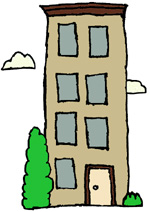In addition to FHA guidelines that are less-specific than ADA specs and thus open to interpretation by both builders and code officials (and sometimes conflict with other regulatory mandates in some markets, such as high-wind or seismic codes), Johnson says multifamily developers make avoidable mistakes that knock them out of compliance with the accessibility laws. In turn, non-compliance can lead to lawsuits and judgments that lean toward remediation; in other words, going back into a finished building to fix what’s wrong.
Common oversights, says Johnson, include the failure to specify doors that allow a minimum 32-inch clear opening; beveled door thresholds that are less than ¾ inch high; roughed-in reinforcement for grab bars around tubs and toilets; and light switches and environmental controls set between 42 and 48 inches above the finished floor—all specified in the code for the sake of someone in a wheelchair or suffering some other physical disability or limitation.
Dealers that are educated (or at least aware) of the FHA and ADA standards can serve in a consulting role with builders, especially those diversifying into multifamily projects from the single-family sector, to make sure they account for such details and recognize compliance issues before breaking ground. “Developers, builders, and contractors often have so much going on [in a multifamily project] that they sometimes just miss things,” says Sarah Perkins, an associate with Tennyson & Geary, a Memphis, Tenn.–based law firm that specializes in fair housing cases.
Dealers also can help their customers by sourcing or perhaps stocking items such as grab bars, wider doors, and compliant thresholds, as well as “upgraded” finishes including lever door handles and D-shaped cabinet pulls (instead of knobs), casement windows, and single-lever faucets—all of which are more easy to manage for someone with a disability.
Suppressing Sound As the for-sale market for multifamily took off amid favorable mortgage terms during the last decade, so did buyer expectations for a single-family experience, including a quiet indoor environment. “Quiet is now part of the definition of comfort,” says Marc Porat, Ph.D., chairman and founder of Quiet Solutions, which manufactures one of several new sound-abatement products on the market.
In some areas, such as California, that expectation has become high enough to entice class-action lawsuits against builders and changes in the state law to tighten building codes, lighten proof of compliance, and require remediation of mistakes or problems related specifically to excessive noise. “Developers may be guilty just because their plans are wrong, even if no one complains or there’s actual damage,” says Sandra Stewart, a partner in the Los Angeles law firm of Cox, Castle & Nicholson.
While multifamily housing is already regulated by code regarding sound suppression between units and from the outdoor environment (specifically, a minimum sound transmission class, or STC, rating for wall and floor-ceiling assemblies), solutions to achieve code compliance often incur installation failures that render them ineffective. “Builders often plan for good acoustical performance, but once all the trades come through, those barriers get breached,” says Nader El-Hajj, a project manager at the NAHB Research Center in Upper Marlboro, Md., which tests various materials for their sound-abatement qualities and claims. “Even small gaps let sound through.”
In addition to new products and assembly systems that purport better sound-abatement performance and more reliable installation, including laminated drywall and subfloor panels, flexible membranes, and laminated windows (more known for their impact resistance in high-wind areas), among others, that are applied in the field just like their traditional counterparts, Stewart advises builders and trades to keep close watch on how they receive, handle, and combine products to achieve a desired standard. “Before you blink in the field, you lose five points on your [STC] rating,” she warns.
As with FHA and ADA compliance regarding accessibility, dealers can help their pro customers involved in multifamily projects by presenting options and caveats regarding sound control products and systems. Stewart also recommends comprehensive training for on-site workers, from receiving to installation, to reduce field failures—a role dealers can play, if not as the experts then as conduits to manufacturer representatives and tech support staff, consultants, and independent inspectors trained to spot and fix potential problems.
And, like products and materials for accessibility compliance, dealers can source solutions for noise abatement, including sound-rated doors and windows, various insulation and sealants, and new-age wall and floor-ceiling panels and membranes. “Manufacturers are doing a great job of refining their products and making them easier to apply,” says John LoVerde, an associate principal with Veneklasen Associates, an acoustical consulting firm based in Santa Monica, Calif., that serves several of the country’s largest home builders, many of which have ventured or soon will venture into multifamily development.



